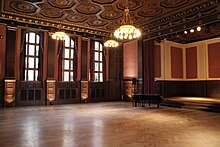
U2 are an Irish rock band formed in Dublin in 1976. The group comprises Bono, the Edge, Adam Clayton, and Larry Mullen Jr.. Initially rooted in post-punk, U2's musical style has evolved throughout their career, yet has maintained an anthemic quality built on Bono's expressive vocals and the Edge's chiming, effects-based guitar sounds. Bono's lyrics, often embellished with spiritual imagery, focus on personal and sociopolitical themes. Popular for their live performances, the group have staged several elaborate tours over their career.

David Howell Evans, better known as the Edge or simply Edge, is a British-Irish musician, singer, and songwriter. He is best known as the lead guitarist, keyboardist, and backing vocalist of the rock band U2. A member of the group since its inception, he has recorded 15 studio albums with them as well as one solo record. His understated style of guitar playing, a signature of U2's music, is distinguished by chiming timbres, use of rhythmic delay, drone notes, harmonics, and an extensive use of effects units.

Achtung Baby is the seventh studio album by the Irish rock band U2. It was produced by Daniel Lanois and Brian Eno, and was released on 18 November 1991 by Island Records. After criticism of their 1988 release Rattle and Hum, U2 shifted their direction to incorporate influences from alternative rock, industrial music, and electronic dance music into their sound. Thematically, Achtung Baby is darker, more introspective, and at times more flippant than their previous work. For his lyrics, lead vocalist Bono was partly inspired by the marital issues of guitarist the Edge.
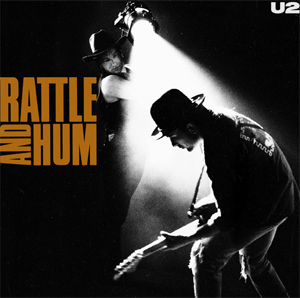
Rattle and Hum is a hybrid live/studio album by Irish rock band U2, and a companion rockumentary film directed by Phil Joanou. The album was produced by Jimmy Iovine and was released on 10 October 1988, while the film was distributed by Paramount Pictures and was released on 27 October 1988. Following the breakthrough success of the band's previous studio album, The Joshua Tree, the Rattle and Hum project captures their continued experiences with American roots music on the Joshua Tree Tour, further incorporating elements of blues rock, folk rock, and gospel music into their sound. A collection of new studio tracks, live performances, and cover songs, the project includes recordings at Sun Studio in Memphis and collaborations with Bob Dylan, B. B. King, and Harlem's New Voices of Freedom gospel choir.
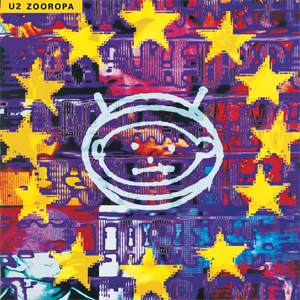
Zooropa is the eighth studio album by Irish rock band U2. Produced by Flood, Brian Eno, and the Edge, it was released on 5 July 1993 on Island Records. Inspired by the band's experiences on the Zoo TV Tour, Zooropa expanded on many of the tour's themes of technology and media oversaturation. The record was a continuation of the group's experimentation with alternative rock, electronic dance music, and electronic sound effects that began with their previous album, Achtung Baby, in 1991.
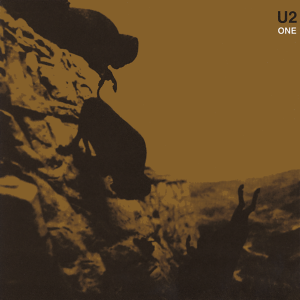
"One" is a song by Irish rock band U2. It is the third track from their seventh album, Achtung Baby (1991), and it was released as the record's third single on 24 February 1992. During the album's recording sessions at Hansa Studios in Berlin, conflict arose between the band members over the direction of U2's sound and the quality of their material. Tensions almost prompted the band to break up until they achieved a breakthrough with the improvisation of "One"; the song was written after the band members were inspired by a chord progression that guitarist the Edge was playing in the studio. The lyrics, written by lead singer Bono, were inspired by the band members' fractured relationships and the German reunification. Although the lyrics ostensibly describe "disunity", they have been interpreted in other ways.
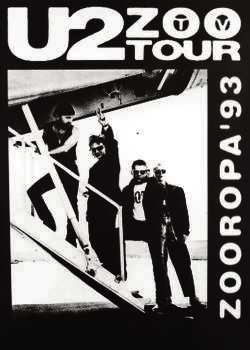
The Zoo TV Tour was a worldwide concert tour by rock band U2. Staged primarily to support their 1991 album Achtung Baby along with their subsequent 1993 album Zooropa, the tour visited arenas and stadiums from 1992 to 1993. Intended to mirror the group's new musical direction on Achtung Baby, the Zoo TV Tour departed from the band's previously austere stage setups by providing an elaborately staged multimedia spectacle, satirising television and media oversaturation by attempting to instill "sensory overload" in its audience. To escape their reputation for being earnest and over-serious, U2 embraced a more lighthearted and self-deprecating image on tour. Zoo TV and Achtung Baby were central to the group's 1990s reinvention.
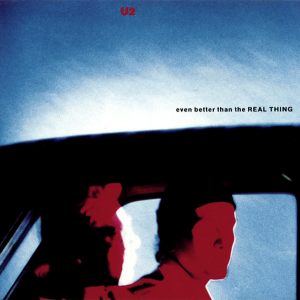
"Even Better Than the Real Thing" is a song by Irish rock band U2, and is the second track on their seventh album, Achtung Baby (1991). It was released as the album's fourth single on 8 June 1992, and it reached number three in Ireland and Canada while becoming a top-ten hit in Austria, New Zealand, and Sweden. A remixed version of the song released the same year peaked at number eight in the United Kingdom and number 10 in Ireland. In 1997, readers of Mojo named the song the 71st-best track of the 1990s.
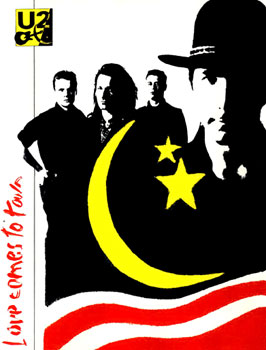
The Lovetown Tour was a concert tour by the Irish rock band U2, which took place in late 1989 and early 1990 following the release of Rattle and Hum. It was documented by noted rock film director Richard Lowenstein in the "LoveTown" documentary.

"Numb" is a song by Irish rock band U2. It is the third track from their eighth album, Zooropa (1993), and was released in June 1993 by Island Records and PolyGram as the album's first single. The song features a monotonous mantra of "don't" commands spoken by guitarist the Edge amidst a backdrop of various sound effects and samples. The noisy composition and lyrical concept for "Numb" were inspired by the theme of sensory overload, which had prominently been incorporated into the Zoo TV Tour. Lead singer Bono and drummer Larry Mullen Jr. provided backing vocals on the track.
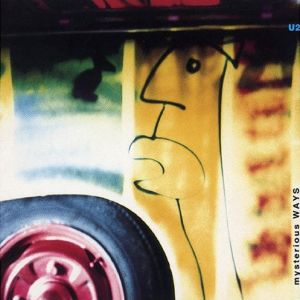
"Mysterious Ways" is a song by Irish rock band U2. It is the eighth track from their 1991 album, Achtung Baby, and was released as the album's second single on 2 December 1991, two weeks after the album. The song began as an improvisation called "Sick Puppy", with the band liking only the bass part that bassist Adam Clayton composed. The band struggled to build a song from it, with vocalist Bono and producer Daniel Lanois arguing intensely during one songwriting session. The song's breakthrough came after guitarist the Edge began experimenting with the Korg A3 effects unit. "Mysterious Ways" features a danceable beat, funky guitar hook, and conga-laden percussion, as well as mystical lyrics by Bono about romance and women.

"The Fly" is a song by Irish rock band U2. It is the seventh track from their 1991 album, Achtung Baby, and it was released as the album's first single on 21 October 1991 by Island Records. "The Fly" introduced a more abrasive-sounding U2, as the song featured danceable hip-hop beats, industrial textures, distorted vocals, and an elaborate guitar solo. Lead vocalist Bono described the song as "the sound of four men chopping down The Joshua Tree", due to its departure from the sound that had traditionally characterised the band in the 1980s.

"Angel of Harlem" is a song by Irish rock band U2. It is the tenth track on their 1988 album Rattle and Hum, and was released as its second single in December 1988. It topped the charts in Canada and New Zealand, and peaked at number nine on the UK Singles Chart, number eight on the Dutch Top 40, number 14 on the Billboard Hot 100, and number one on the Mainstream Rock Tracks chart. Written as a homage to Billie Holiday, it was released with two different B-sides; one was an original U2 song called "A Room at the Heartbreak Hotel", while the other was a live version of Rattle and Hum's "Love Rescue Me".
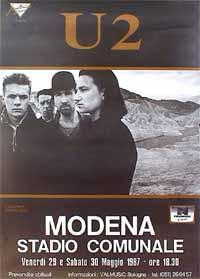
The Joshua Tree Tour was a concert tour by Irish rock band U2. Staged in support of their 1987 album The Joshua Tree, it comprised 109 shows over three legs, spanning from April to December that year. The first and third legs visited North America, while the second leg toured Europe. Although it featured minimal production like the group's previous tours, the Joshua Tree Tour was the first to involve larger venues in arenas and stadiums as a result of the album's breakthrough. Much like U2 did on The Joshua Tree, on tour the group explored social and political concerns, along with American roots and mythology, collaborated with American guest musicians and opening acts such as B. B. King. U2 also recorded new material; these songs and their experiences on tour were depicted on the 1988 album and documentary film Rattle and Hum and on the 2007 video and live album Live from Paris. Territories that this tour missed would later be covered by Rattle and Hum's Lovetown Tour.
"Zoo Station" is a song by Irish rock band U2. It is the opening track from their 1991 album Achtung Baby, a record on which the group reinvented themselves musically by incorporating influences from alternative rock, industrial, and electronic dance music. As the album's opening track, "Zoo Station" introduces the band's new sound, delivering industrial-influenced percussion and several layers of distorted guitars and vocals. Similarly, the lyrics suggest the group's new intents and anticipations. The introduction, featuring an "explosion" of percussion and a descending glissando for a guitar hook, was meant to make the listener think the album was mistakenly not U2's latest record or that their music player was broken.
This is a timeline of the history of rock band U2:
"Acrobat" is a song by rock band U2, and is the eleventh track on their 1991 album Achtung Baby. The song developed from a riff created by guitarist the Edge, and is played in a 12
8 time signature. Lyrically, the song expresses themes of hypocrisy, alienation, and moral confusion. Although "Acrobat" was rehearsed prior to the third leg of the Zoo TV Tour, it had not been performed live until its debut on the Experience + Innocence Tour on 2 May 2018.
"Love Is Blindness" is a song by rock band U2, and the twelfth and final track on their 1991 album Achtung Baby. The song was written on piano by lead singer Bono during the recording sessions for U2's 1988 album Rattle and Hum. Originally intending to give the song to singer Nina Simone, the band decided to keep it for Achtung Baby after playing it together. Thematically, the song describes a failing romance, mixing personal themes with imagery of metaphorical acts of terrorism. During the recording sessions for Achtung Baby, guitarist the Edge separated from his wife, Aislinn O'Sullivan. The separation had a major effect on the development of the song; Bono said that the ending guitar solo was a cathartic experience for the Edge, as he snapped several guitar strings during the recording.
"So Cruel" is a song by rock band U2. It is the sixth track on their 1991 album Achtung Baby, concluding side one of the album. The song was written at Elsinore in Dalkey. While audio engineer Flood changed reels to listen to a demo of another song, lead singer Bono began to improvise a song on guitar. The rest of the band quickly joined in, creating the first take of the song. It was developed as an acoustic track, with Flood adding overdubs and additional elements later. Bassist Adam Clayton and Flood noted that the technology in the studio was crucial in transforming the acoustic song into the final mix.


